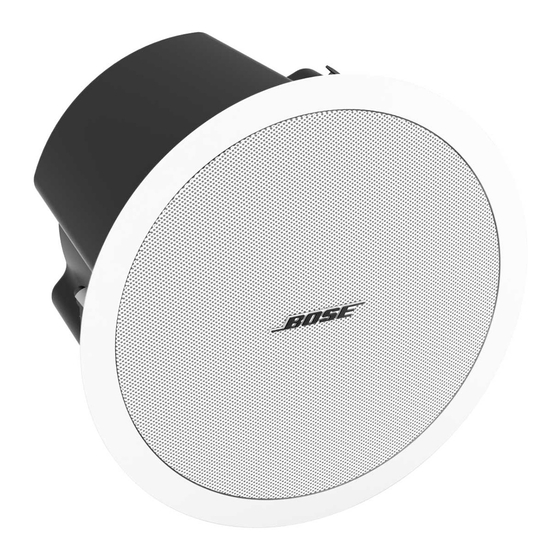Bose FreeSpace DS 100SE Instrukcja serwisowa - Strona 18
Przeglądaj online lub pobierz pdf Instrukcja serwisowa dla Głośniki Bose FreeSpace DS 100SE. Bose FreeSpace DS 100SE 21 stron. With ceiling mount bracket
Również dla Bose FreeSpace DS 100SE: Instrukcja obsługi (32 strony), Instrukcja instalacji (17 strony), Arkusz danych technicznych (8 strony), Instrukcja instalacji (22 strony), Podręcznik projektowania (4 strony)

FreeSpace DS 100F Flush-Mount
Loudspeaker
1. Air Leak Test
1.1 Remove the loudspeaker grille using
disassembly procedure 1. Set the TAP
rotary switch to the 8 Ohm position.
1.2 Apply a 12.5 Vrms, 80 Hz signal to the
8 Ohm input of the loudspeaker.
1.3 Listen for air leaks around the drivers,
baffle and input terminal area. Re-align or
replace any leaking gaskets. Replace any
driver that has a rubbing or ticking noise.
2. Rub and Tick Test
2.1 Remove the loudspeaker grille using
disassembly procedure 1. Set the TAP
rotary switch to the 8 Ohm position.
2.2 Apply a 12.5 Vrms, 30 Hz signal to the
8 Ohm input of the loudspeaker.
2.3 Listen to the drivers for any rubbing,
ticking or other extraneous noise. Replace
any defective driver. Small ticks are accept-
able if they cannot be heard at a distance of
one foot.
Note: There is a normal suspension noise.
To distinguish between a rub or a tick and
suspension noise, displace the cone slightly
with your finger. If the rubbing can be made
to go away or get worse, it is a rub or a tick.
If the noise stays the same, it is suspension
noise.
TEST PROCEDURES
18
3. Power Sweep Test
3.1 Remove the loudspeaker grille using
disassembly procedure 1. Set the TAP rotary
switch to the 8 Ohm position.
3.2 Apply a 12.5 Vrms, 50 Hz signal to the
8 Ohm input of the loudspeaker.
3.3 Slowly sweep the oscillator frequency
from 50 Hz to 5 kHz. Listen for any buzzes,
rattles or other extraneous noises from the
drivers or from the internal parts. Test sweep
time should be about 3 seconds up and 3
seconds down. Replace any driver that has
a buzzing noise.
Note: The whooshing noise from the port at
around 80Hz is acceptable.
4. Transformer TAP Select Test
4.1 Apply a 70 Vrms, 100 Hz signal to the
70/100V loudspeaker input.
4.2 Slowly change the TAP selection switch
from the 100W position to the 12.5W posi-
tion. A decrease in audio output level should
be heard for each descending TAP position
of the switch.
